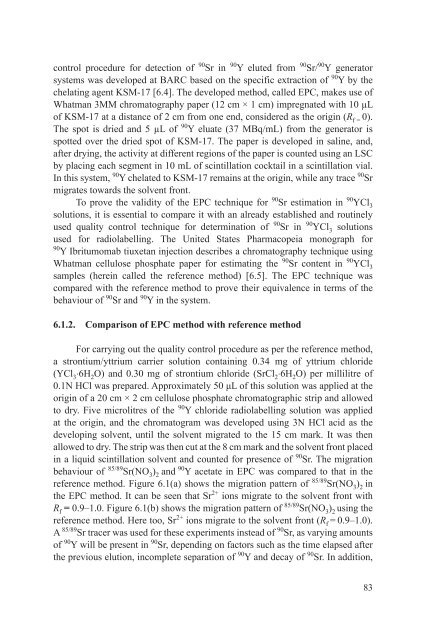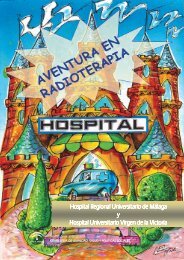Yttrium-90 and Rhenium-188 Radiopharmaceuticals for Radionuclide Therapy
Pub1662web-89688003
Pub1662web-89688003
Create successful ePaper yourself
Turn your PDF publications into a flip-book with our unique Google optimized e-Paper software.
control procedure <strong>for</strong> detection of <strong>90</strong> Sr in <strong>90</strong> Y eluted from <strong>90</strong> Sr/ <strong>90</strong> Y generator<br />
systems was developed at BARC based on the specific extraction of <strong>90</strong> Y by the<br />
chelating agent KSM-17 [6.4]. The developed method, called EPC, makes use of<br />
Whatman 3MM chromatography paper (12 cm × 1 cm) impregnated with 10 µL<br />
of KSM-17 at a distance of 2 cm from one end, considered as the origin (R f = 0).<br />
The spot is dried <strong>and</strong> 5 µL of <strong>90</strong> Y eluate (37 MBq/mL) from the generator is<br />
spotted over the dried spot of KSM-17. The paper is developed in saline, <strong>and</strong>,<br />
after drying, the activity at different regions of the paper is counted using an LSC<br />
by placing each segment in 10 mL of scintillation cocktail in a scintillation vial.<br />
In this system, <strong>90</strong> Y chelated to KSM-17 remains at the origin, while any trace <strong>90</strong> Sr<br />
migrates towards the solvent front.<br />
To prove the validity of the EPC technique <strong>for</strong> <strong>90</strong> Sr estimation in <strong>90</strong> YCl 3<br />
solutions, it is essential to compare it with an already established <strong>and</strong> routinely<br />
used quality control technique <strong>for</strong> determination of <strong>90</strong> Sr in <strong>90</strong> YCl 3 solutions<br />
used <strong>for</strong> radiolabelling. The United States Pharmacopeia monograph <strong>for</strong><br />
<strong>90</strong> Y Ibritumomab tiuxetan injection describes a chromatography technique using<br />
Whatman cellulose phosphate paper <strong>for</strong> estimating the <strong>90</strong> Sr content in <strong>90</strong> YCl 3<br />
samples (herein called the reference method) [6.5]. The EPC technique was<br />
compared with the reference method to prove their equivalence in terms of the<br />
behaviour of <strong>90</strong> Sr <strong>and</strong> <strong>90</strong> Y in the system.<br />
6.1.2. Comparison of EPC method with reference method<br />
For carrying out the quality control procedure as per the reference method,<br />
a strontium/yttrium carrier solution containing 0.34 mg of yttrium chloride<br />
(YCl 3 ⋅6H 2 O) <strong>and</strong> 0.30 mg of strontium chloride (SrCl 2 ⋅6H 2 O) per millilitre of<br />
0.1N HCl was prepared. Approximately 50 μL of this solution was applied at the<br />
origin of a 20 cm × 2 cm cellulose phosphate chromatographic strip <strong>and</strong> allowed<br />
to dry. Five microlitres of the <strong>90</strong> Y chloride radiolabelling solution was applied<br />
at the origin, <strong>and</strong> the chromatogram was developed using 3N HCl acid as the<br />
developing solvent, until the solvent migrated to the 15 cm mark. It was then<br />
allowed to dry. The strip was then cut at the 8 cm mark <strong>and</strong> the solvent front placed<br />
in a liquid scintillation solvent <strong>and</strong> counted <strong>for</strong> presence of <strong>90</strong> Sr. The migration<br />
behaviour of 85/89 Sr(NO 3 ) 2 <strong>and</strong> <strong>90</strong> Y acetate in EPC was compared to that in the<br />
reference method. Figure 6.1(a) shows the migration pattern of 85/89 Sr(NO 3 ) 2 in<br />
the EPC method. It can be seen that Sr 2+ ions migrate to the solvent front with<br />
R f = 0.9–1.0. Figure 6.1(b) shows the migration pattern of 85/89 Sr(NO 3 ) 2 using the<br />
reference method. Here too, Sr 2+ ions migrate to the solvent front (R f = 0.9–1.0).<br />
A 85/89 Sr tracer was used <strong>for</strong> these experiments instead of <strong>90</strong> Sr, as varying amounts<br />
of <strong>90</strong> Y will be present in <strong>90</strong> Sr, depending on factors such as the time elapsed after<br />
the previous elution, incomplete separation of <strong>90</strong> Y <strong>and</strong> decay of <strong>90</strong> Sr. In addition,<br />
83




